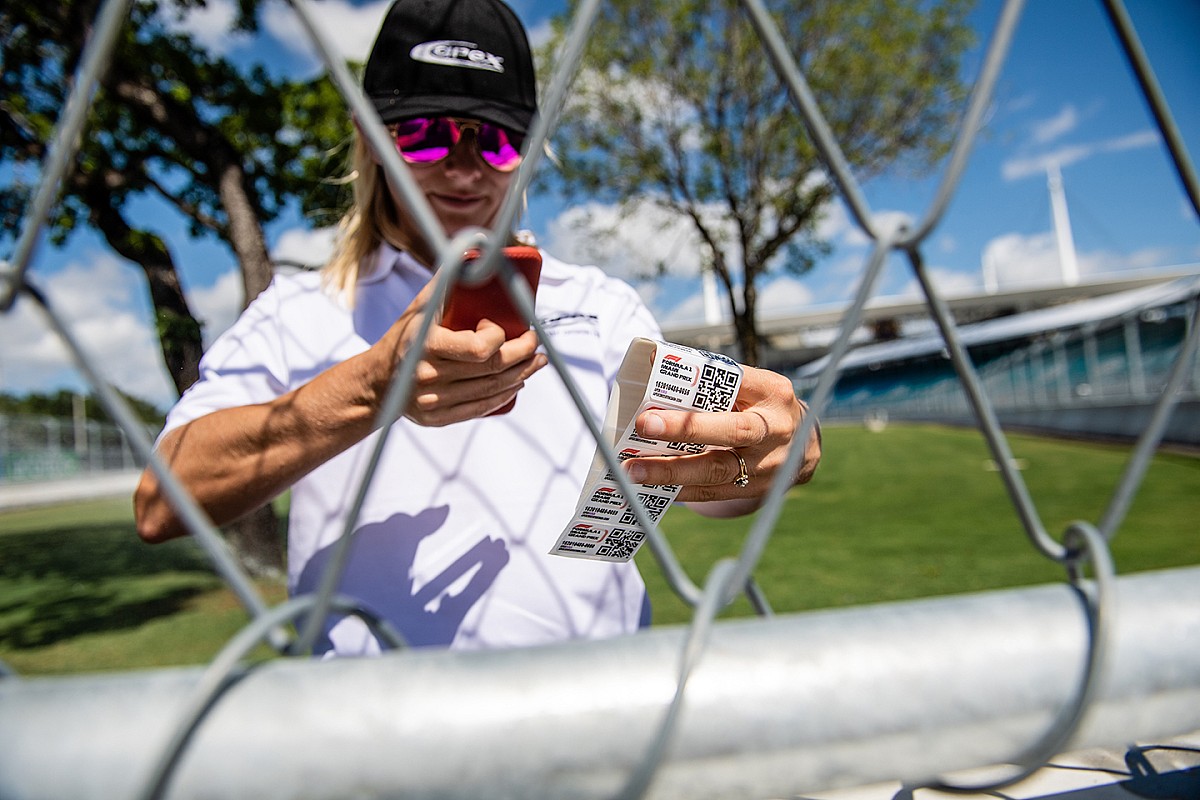
One of the challenges of the new Miami International Autodrome is that it’s built around a bustling football stadium, tennis courts and a concert venue that requires the facility’s outlying areas to change shape for each event it stages.
This meant that Apex Circuit Design, who oversaw the project from masterplanning to delivery, had to come up with a system to keep track of all 2,900 Geobrugg concrete barriers, debris fencing and kerbs – in all over 7000 assets – that needed to be installed. Then, after the Miami Grand Prix has taken place, it all has to be removed to allow for the stadium’s next event to take place, with the assistance of software development firm Ofcdesk.
The solution was ApexBUILD, which is a ‘digital twin’ and asset management tool of the entire racetrack’s layout, and is the responsibility of Kate Kishel for Apex to develop.
Each ApexBUILD asset tag carries an individual QR code (a small piece of vinyl with a 5mm adhesive that is also used by NASA) that she has been adhering to all the pieces after they’ve been put in place to form the barriers of the track, which she then scans with a mobile app to update site data in real time.
“A digital twin is a visual replication of a real-life entity – in this case the assets of a construction site,” said Kishel. “But you could have a digital twin to model any system or entity.
“One of the challenges of structures on a temporary racetrack is all of these giant concrete barriers with wire fences on top. They are like very heavy, 13-feet long Lego bricks! They all need to be linked together in a perfect configuration to complete the track.
“These assets are challenging to manage because of their number and size – so imagine install plans aren’t followed as designed, you’d need additional specialized labour and equipment to fix it and get back on track, and that could delay your schedule and incur additional cost.”

These asset tags mean that each component of the track, apart from the permanent racing surface and drainage system, can be monitored virtually on a web app to allow for their assembly and deconstruction – data that can then be used to reassemble the following year.
Kishel explained: “We use AutoCAD, which is a design software that’s used by engineers to design a facility and put site plans in place, which creates a picture of what the site should look like when everything is installed. The ApexBUILD mobile app does, once it has scanned any QR stickers with the mobile app, is gather all this data for each component, so its own story is captured in our back-end database. Then the ApexBUILD web viewer displays the data in an easy-to-understand graphical display that anyone can see an understand, with little to no training, in a few seconds.
“You go from having the picture of what the site should look like, now combined with the actual data of what’s physically built, so you can compare the two to ensure there are no errors. It’s basically a method of ensuring all these giant Legos are in the place they’re meant to be.
“It also creates a story of each concrete barrier forever – so if one gets damaged and needs repairing there’s a record of what happened, so we can be sure to repair the correct barrier before next year’s race to improve safety. And, moreover, that barrier’s lifespan is recorded perfectly.”
ApexBUILD works in conjunction with Autodesk Build and will be used to establish an asset and life-management database for inventory control and to log the location and condition each year for off-site storage. This will assist the project management team annually to reinstall the track systems, in the order they are removed following each year’s race.
“We also have the kerbs, debris fence panels and TecPro barriers,” added Kishel. “We started with a blank canvas but the rate that the guys have built this track has been mind-boggling. It’s been a tough task to keep up with them!”
The system will face a test this weekend when the public access road of Don Shula Avenue is closed and then re-opened each morning and evening. The barriers and fences that are moved can be checked to ensure they’ve been assembled/de-assembled correctly and in real time.
“People make mistakes, but the computer tracks everything perfectly,” said Kishel. “For example, when I was tagging some barriers on the start/finish straight last month, ApexBUILD showed that there was only one row of concrete blocks when there should’ve been a double row for safety. It was a simple oversight, captured by the app but missed by the installation team.
“On a hugely busy construction site, mistakes like this can happen, but the digital twin clearly shows any discrepancy between what we planned to happen and what is actually happening.”
And what if the stickers peel off over time?
“I know the manufacturer, I talk to him bi-weekly, and I think I might have made his life a misery,” she quipped. “But he did test the asset tags by putting them on the tread of a bulldozer and driving it around for 12 hours.
“He’s a Floridan, so he understands how hot and rainy it can get here.”







